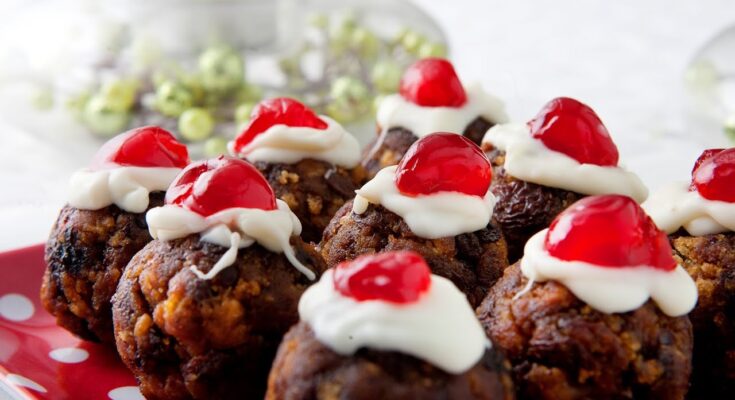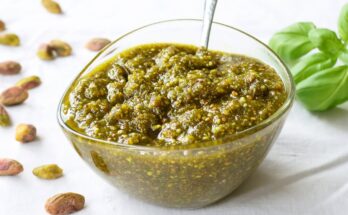Plum Pudding Recipe: Plum pudding, often called Christmas pudding, is a rich, dark, and moist dessert that’s synonymous with the holiday season. Despite its name, plum pudding doesn’t always contain plums. Historically, the word “plum” referred to any dried fruit, such as raisins or currants. This delightful dessert is deeply embedded in British tradition and has become a festive favorite around the world.
What is Plum Pudding?
Plum pudding is a steamed or boiled dessert made from dried fruits, breadcrumbs, suet, eggs, flour, and spices. It’s typically moistened with brandy or other spirits, which not only enhance its flavor but also act as a preservative. The pudding is aged for several weeks or even months before being served, allowing the flavors to deepen and develop into a rich, aromatic treat.
History and Origin of Plum Pudding
The origins of plum pudding date back to medieval England, where it began as a savory dish made with meat and root vegetables. Over time, it evolved into a sweet dessert, especially by the Victorian era when it became a staple of Christmas celebrations. The traditional ritual of “Stir-Up Sunday,” observed five weeks before Christmas, involved families gathering to stir the pudding mixture while making a wish — a cherished tradition that continues today.
Why Plum Pudding is Perfect for Festive Seasons
Plum pudding isn’t just a dessert; it’s a symbol of togetherness and celebration. Its warm spices, fruity aroma, and indulgent flavor evoke feelings of nostalgia and comfort. Whether served with brandy sauce or custard, it captures the essence of holiday cheer and the joy of sharing. Preparing it ahead of time also means you can focus on enjoying the festivities when Christmas arrives.
Ingredients You’ll Need
Before diving into the cooking process, let’s gather all the essential ingredients for your perfect plum pudding. This combination of fruits, spices, and rich ingredients is what gives the pudding its signature taste and texture.
Key Ingredients
- Dried fruits: 1 cup raisins, 1 cup currants, ½ cup chopped dates, ½ cup chopped prunes
- Candied peel: ½ cup mixed peel for a zesty note
- Flour: 1 cup all-purpose flour
- Breadcrumbs: 1 cup fresh or dry breadcrumbs
- Brown sugar: ¾ cup, for a rich caramel flavor
- Suet or butter: 1 cup shredded suet or softened unsalted butter
- Eggs: 3 large eggs, lightly beaten
- Milk or stout: ½ cup for moisture and depth
- Brandy or rum: ¼ cup (optional, enhances flavor and preserves the pudding)
- Baking soda: 1 teaspoon
- Spices: 1 teaspoon each of cinnamon, nutmeg, and mixed spice
- Salt: A pinch to balance sweetness
- Grated apple or carrot: ½ cup (adds natural sweetness and moisture)
Optional Additions and Variations
- Chopped nuts (walnuts, almonds, or pecans) for texture
- Orange zest or lemon zest for a citrusy lift
- Honey or treacle for deeper color and richness
- Dark chocolate chips for a modern twist
Ingredient Substitutes for Dietary Preferences
- For vegetarian pudding, replace suet with butter or coconut oil.
- For gluten-free, use gluten-free flour and breadcrumbs.
- For non-alcoholic, substitute brandy with orange juice or apple cider.
- For low-sugar, reduce brown sugar and use naturally sweet fruits like figs or dates.
Gathering the right ingredients and measuring them accurately is key to a pudding that’s rich, moist, and bursting with holiday flavor.
Equipment Required
Before you start mixing and steaming, it’s crucial to prepare your kitchen with the right tools.
Kitchen Tools and Utensils
- Large mixing bowl
- Wooden spoon or spatula
- Measuring cups and spoons
- Pudding basin (1.5 to 2-liter capacity)
- Steaming pot or large saucepan
- Foil and parchment paper
- Kitchen string
- Cooling rack
Recommended Pudding Basin or Mold
A ceramic pudding basin works best, as it distributes heat evenly. However, metal or silicone molds are also suitable alternatives. Just ensure they are heatproof and deep enough to allow the pudding to rise slightly.
Preparing Your Equipment
Before starting, grease your pudding basin with butter and line the bottom with parchment paper to prevent sticking. Make sure your steaming pot has a lid and enough water to last throughout the steaming process (usually 4–6 hours). It’s a good idea to place a small metal ring or folded towel at the bottom of the pot to prevent the basin from touching the direct heat.
Step-by-Step Guide to Making Plum Pudding
Step 1: Preparing the Fruits
Finely chop a mix of dried fruits — raisins, currants, prunes, sultanas, and candied peel. Place them in a large bowl and soak overnight in rum, brandy, or orange juice along with a bit of zest from lemon or orange. This soaking process infuses the fruits with rich, festive flavor and ensures the pudding stays moist.
Step 2: Mixing the Batter
In a separate bowl, cream together butter and brown sugar until fluffy. Beat in eggs one at a time, then add breadcrumbs and flour mixed with warm spices like cinnamon, nutmeg, and clove. Stir in the soaked fruits along with chopped nuts and a splash of molasses or treacle for that dark, traditional richness. Mix until everything is well combined — the batter should be thick and glossy.
Step 3: Steaming the Pudding
Grease a pudding basin and line the bottom with parchment paper. Pour in the batter, leaving about an inch of space at the top for expansion. Cover tightly with foil or a pudding cloth. Place the basin in a large pot, add enough boiling water to reach halfway up the sides, and steam gently for about 5–6 hours, topping up the water as needed. The slow steaming gives it that dense, luxurious texture.
Step 4: Storing and Aging the Pudding
Once steamed, let the pudding cool completely. Remove the foil, replace it with fresh parchment and foil, and store in a cool, dark place for at least a few weeks — or even up to two months. The longer it ages, the deeper the flavor becomes as the fruits and spices meld beautifully.
Step 5: Reheating and Serving
When ready to serve, re-steam the pudding for about 1 hour until heated through. Turn it out onto a serving plate and, for a classic touch, drizzle with warm brandy and set it aflame briefly before serving. Slice and enjoy with warm custard, brandy butter, or whipped cream — rich, nostalgic, and utterly festive!
Tips for the Perfect Plum Pudding
Common Mistakes to Avoid
- Skipping the soaking step: Rushing the fruit-soaking process can result in a dry, unevenly flavored pudding.
- Under-steaming: If your pudding isn’t steamed long enough, it won’t achieve that deep, dark texture and could taste raw.
- Overfilling the basin: Leave enough space at the top for expansion to prevent overflow during steaming.
- Not sealing the basin properly: Steam can seep in and make your pudding soggy if not wrapped correctly.
- Forgetting to top up the water: Always keep an eye on the pot during steaming — if the water level drops too low, your pudding could burn.
Expert Tips for Rich Flavor
- Use dark brown sugar or molasses for a richer color and caramel-like flavor.
- Add a splash of espresso or black treacle to enhance depth.
- Allow at least 4 weeks of aging for optimal taste.
- “Feed” your pudding with brandy weekly for a boozy, aromatic finish.
How to Keep it Moist and Flavorful
Moisture is key to a perfect plum pudding. Adding grated apple or carrot, or even a spoonful of marmalade, helps maintain that soft texture. When storing, keep the pudding tightly sealed and occasionally moisten it with brandy or juice. During reheating, steam rather than microwave to retain its original richness and consistency.
A well-made plum pudding should be dense yet soft, rich but not overly sweet — an indulgent dessert that feels like a warm hug on a winter evening.
Serving Suggestions
Traditional Sauces and Garnishes
The classics never fail. Pair your plum pudding with brandy butter, vanilla custard, or warm cream. For a lighter twist, drizzle with lemon sauce or cognac cream. Garnish with a sprig of holly or a dusting of powdered sugar for a beautiful presentation.
Modern Twists on Serving Plum Pudding
If you’re feeling creative, try serving slices of plum pudding with ice cream or salted caramel sauce. Leftover pudding can be crumbled into trifles, mixed into ice cream, or even baked into muffins or bread pudding the next day. The options are endless — it’s the dessert that keeps on giving!
Storing and Preserving Plum Pudding
Short-Term Storage
After steaming your pudding, let it cool completely at room temperature. Once cooled, wrap it tightly in a layer of baking parchment followed by aluminum foil. Store it in a cool, dark, and dry place — such as a pantry or cupboard. It will stay fresh for several weeks, especially if you plan to enjoy it within a month.
To keep it moist, “feed” your pudding every week by unwrapping it slightly and drizzling a spoonful of brandy, rum, or sherry over the top before rewrapping. This not only enhances the flavor but also helps preserve it naturally. Remember to keep it in an airtight container to prevent it from absorbing other odors from your kitchen.
If your pudding feels slightly dry when you check it, don’t panic! You can restore its moisture by wrapping it in parchment paper, sprinkling with a bit more brandy, and letting it rest for 24 hours before reheating.
Long-Term Preservation Methods
If you want to prepare your plum pudding months in advance, freezing is the best method for long-term storage. Once the pudding has cooled completely, wrap it tightly in plastic wrap and foil, then place it in a freezer-safe bag or container. Properly stored, it can last for up to six months without losing flavor or texture.
When you’re ready to enjoy it, thaw the pudding in the refrigerator overnight, then steam for about 2 hours before serving. Freezing doesn’t affect the taste — in fact, many cooks say it enhances the richness because the ingredients continue to mature even while frozen.
Another traditional preservation method involves sealing the pudding in a tin and storing it in a cool cellar or pantry. With regular feeding and proper wrapping, a well-made plum pudding can last for up to a year — making it a dessert that truly stands the test of time.
Nutritional Information
Calories and Macronutrients
While plum pudding is undeniably indulgent, it’s also packed with energy and nutrients. Here’s a rough nutritional breakdown for a single serving (approximately 150g):
| Nutrient | Amount (per serving) |
|---|---|
| Calories | 350–420 kcal |
| Carbohydrates | 60–70g |
| Sugars | 45–55g |
| Fat | 10–15g |
| Protein | 4–6g |
| Fiber | 4–5g |
| Alcohol (if used) | Minimal once cooked |
Most of the calories come from the dried fruits and sugar, which provide quick energy — perfect for the cold festive season. The fat content largely depends on whether you use suet or butter, while the fiber comes from the fruits and breadcrumbs.
Health Benefits and Considerations
Despite being a rich dessert, plum pudding has some surprising health benefits. The dried fruits — like raisins, prunes, and dates — are high in fiber, iron, and antioxidants. The spices, such as cinnamon and nutmeg, help with digestion and provide warmth, which is especially comforting in winter.
However, moderation is key. Plum pudding can be high in sugar and fat, so enjoying it as a festive treat rather than a regular dessert is the healthiest approach. For a lighter version, try using whole-grain breadcrumbs, less sugar, and non-alcoholic alternatives such as orange juice or apple cider.
If you’re catering to dietary restrictions, this dessert can easily be adapted to be vegan, gluten-free, or low-sugar without losing its authentic taste.
FAQs about Plum Pudding Recipe
1. Can I make Plum Pudding without alcohol?
Absolutely! Instead of brandy or rum, use freshly squeezed orange juice, apple juice, or spiced tea to soak your dried fruits. You’ll still achieve that rich, deep flavor without any alcohol content. Many families prefer this option, especially when serving children or those who avoid alcohol.
2. How long should I steam the pudding?
For the best results, steam your pudding for at least 6 hours the first time you cook it. If you’re making smaller puddings, 4 hours is usually enough. When reheating before serving, steam it again for about 2 hours to restore its moist texture and warmth.
3. Can I freeze Plum Pudding?
Yes, and it freezes beautifully! Just make sure it’s cooled completely before wrapping in parchment, foil, and a freezer-safe bag. When ready to serve, thaw overnight in the fridge and steam for 2 hours before serving. The flavor often improves after freezing.
4. What’s the difference between Christmas pudding and Plum pudding?
They’re essentially the same thing! “Plum pudding” is the traditional term, while “Christmas pudding” became popular during the Victorian era. Both refer to a rich, fruity dessert served during the festive season — the name simply varies by region.
5. How do I fix a dry pudding?
If your pudding turns out dry, poke small holes on top and drizzle with a few tablespoons of warm brandy or orange juice. Wrap it tightly and let it rest for 24 hours before reheating. Steaming it again will help reintroduce moisture and soften the texture.
Conclusion
Making a plum pudding is more than just a recipe — it’s an experience steeped in tradition, warmth, and family togetherness. From soaking the fruits to lighting the brandy flame, every step brings its own joy and sense of anticipation. This dessert isn’t rushed; it’s lovingly prepared over time, capturing the spirit of patience and celebration.
Whether you stick to the classic British method or put your own modern twist on it, the result will always be a show-stopping centerpiece for your festive table. The deep, rich aroma, the comforting sweetness, and that touch of nostalgia make every bite unforgettable.
So, gather your ingredients, stir in your wishes, and get ready to create a pudding that will be talked about for Christmases to come!



